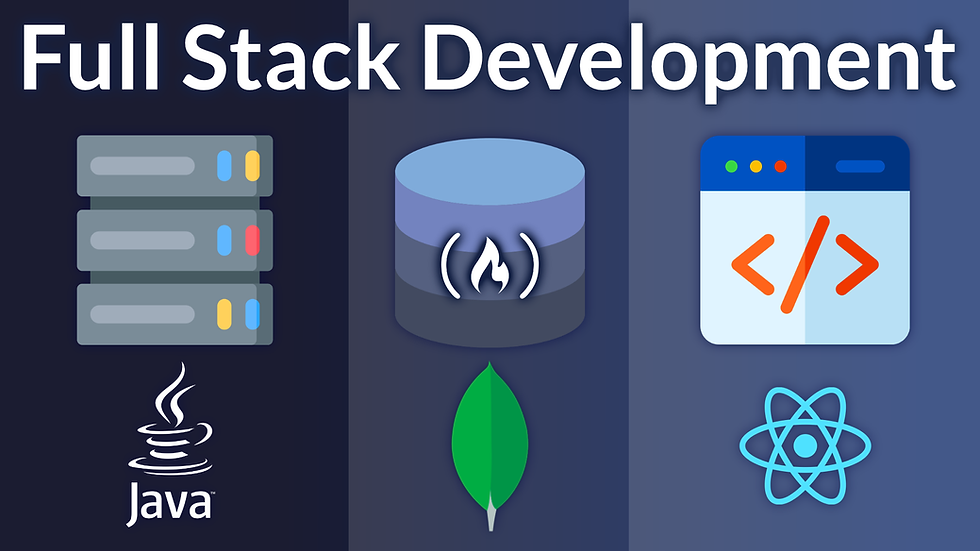The Rise of Full Stack Development: Mastering the Art of Web Applications
- Purva Yadav

- May 18, 2024
- 3 min read

In today's digital landscape, full stack development has become an essential skill for building robust and efficient web applications. Full stack developers, proficient in both front-end and back-end technologies, are invaluable assets to any tech team. This blog explores the core of full stack development, its components, and how mastering it can enhance your career in the tech industry.
What is Full Stack Development?
Working on a web application's front end and back end is known as full stack development. A full stack developer can create a complete web application from scratch, managing both client-side and server-side functionalities.
The Front-End
The front-end, or client-side, is what users interact with directly in their browsers. It includes everything that users see and experience: the layout, design, and interactive elements of a website or web application. Key technologies for front-end development include:
HTML (HyperText Markup Language): The foundation of any web page, providing structure and content.
CSS (Cascading Style Sheets): Responsible for the styling, layout, and visual presentation of web pages.
JavaScript: A programming language that adds interactivity and dynamic behavior to websites.
Frameworks and Libraries: Tools like React, Angular, and Vue.js streamline development and enhance functionality.
The Back-End
The back-end, or server-side, manages the business logic, database interactions, user authentication, and server configuration. It ensures that the front-end gets the right data and functions correctly. Essential back-end technologies include:
Programming Languages: Languages such as JavaScript (Node.js), Python, Ruby, PHP, and Java are commonly used.
Databases: Tools like MySQL, PostgreSQL, MongoDB, and Redis store and manage application data.
Server Management: Understanding servers, APIs (Application Programming Interfaces), and cloud services like AWS, Azure, or Google Cloud Platform is crucial.
The Importance of Full Stack Development
Versatility and Flexibility
Full stack developers can navigate and manage both client-side and server-side development. This versatility makes them highly adaptable and capable of contributing to multiple aspects of a project, making them valuable to employers seeking efficient use of resources.
Seamless Coordination
With a comprehensive understanding of both ends of a web application, full stack developers can ensure seamless integration between the front-end and back-end. This holistic approach can lead to more cohesive and efficient development processes.
Cost Efficiency
Hiring a full stack developer can be more cost-effective for startups and small businesses, as it reduces the need for separate front-end and back-end developers. A full stack developer can handle multiple roles, thereby lowering operational costs.
Enhanced Troubleshooting
A full stack developer’s broad skill set allows for better troubleshooting and problem-solving across the entire application. They can identify and resolve issues that span both the front-end and back-end, leading to quicker fixes and less downtime.
Becoming a Full Stack Developer
Learning Path
Start with HTML, CSS, and JavaScript to build a strong foundation in front-end development.
Explore front-end frameworks like React or Angular to enhance your skills.
Learn a back-end programming language (e.g., Node.js, Python, or Ruby).
Gain experience with databases and server management.
Understand frameworks that integrate both front-end and back-end, such as MERN (MongoDB, Express.js, React, Node.js) or MEAN (MongoDB, Express.js, Angular, Node.js).
Master version control systems like Git.
Familiarize yourself with collaborative tools like GitHub or GitLab.
Build real-world projects to apply your knowledge.
Contribute to open-source projects or freelance to gain diverse experience.
The Future of Full Stack Development
As technology evolves, the demand for skilled full stack developers is expected to grow. Emerging technologies like artificial intelligence, machine learning, and the Internet of Things (IoT) are expanding the scope of full stack development. Moreover, the rise of remote work and global collaboration has increased the need for versatile developers who can manage multiple aspects of web development.
Trends to Watch
Serverless Architecture: Reducing the complexity of back-end management by leveraging cloud services.
Progressive Web Apps (PWAs): Combining the best of web and mobile apps to enhance user experiences.
Microservices: Breaking down applications into smaller, manageable services for better scalability and maintenance.
Conclusion
Mastering full stack development can significantly enhance your career prospects in the tech industry. By understanding both the front-end and back-end of web applications, you become a versatile and valuable asset capable of driving projects from concept to completion. As the digital landscape continues to evolve, full stack developers will remain at the forefront of innovation, transforming ideas into reality with their comprehensive skill set. Whether you are a beginner or an experienced developer, enrolling in a Full Stack Development course in Navi Mumbai, Mumbai, Thane, Delhi, Noida and other cities can be a crucial step towards embarking on the journey to becoming a full stack developer, paving the way for a dynamic and rewarding career.



Comments